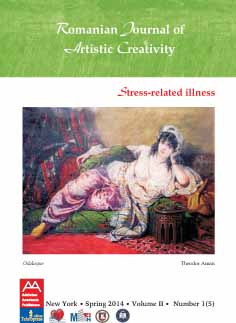Mind rhythms of perception, anxiety and creativity
Mind rhythms of perception, anxiety and creativity
Author(s): Mihai A. StroeSubject(s): Literary Texts
Published by: Addleton Academic Publishers
Keywords: anxiety; clinamen; pataphysics; shamans; originals; imitators; ancients; moderns; labyrinth; agon; canon; brain waves; mother tongue
Summary/Abstract: By now recognized worldwide as one of the strongest critics of the 20th century, Harold Bloom brought to light a dimension of human creativity that had but rarely been tackled in literary criticism, owing to the great complexity of the matter, namely the question of literary, cultural and cognitive influence in the act of creation. The present research attmpts to offer a “simplex” overview of Bloom’s critical system: by exploring his critical approach, whereby a vast network of cognitive relationships between creators and their creations is probed, we aim to reach the simplest structural foundations of Bloom’s thought system. In the final analysis the latter constitutes a strong tool for understanding creativity as a kind of shamanic battle (or agon) for the expression of one’s right of self-assertion, led under the sign of an all-pervading multidimensional labirinthine rainbowlike influence that springs, in various stages and degrees, from an indefinite and inscrutably deep past; it spreads like a universal gnostic tree, whose branches are endless discrete “rays” of cognitive influence, infinite spectra of cognitive mental energies-rhythms climbing higher and higher into the future. In a context in which we consider also the influences having operated upon Bloom himself in the very process whereby he forged his own critical system – in this sense we especially focus on Edward Young’s proto-romantic manifesto dealing with the question of originality, imitation, and the relationship between the ancients (as predecessors) and the moderns – we hereby attempt to show that Bloom created a powerful instrument for exploring the past, the present and the future: a kind of critical telescope for probing the global networks of influence established between creators and their creations of all times and places, with a view to understanding the present and the discrete mechanisms by agency of which canons are created, thereby leading us to an understanding and anticipation of the possible futures. Bloom thus offers us a critical method – based, among other things, on Alfred Jarry’s concept of pataphysics as a science of exceptions/anomalies/particulars and of “imaginary solutions” emerging from intellectual common sense – for reaching what could well be described as the condition of cognitive shamans who in their quest try to find fundamental keys for gaining insight into the canons worldwide. Such a key is the six-step way of poetic creativity, which we explore alongside the six-wave “rainbow” model of the brain.
Journal: Romanian Journal of Artistic Creativity
- Issue Year: 2014
- Issue No: 1
- Page Range: 66-116
- Page Count: 51
- Language: English
- Content File-PDF

